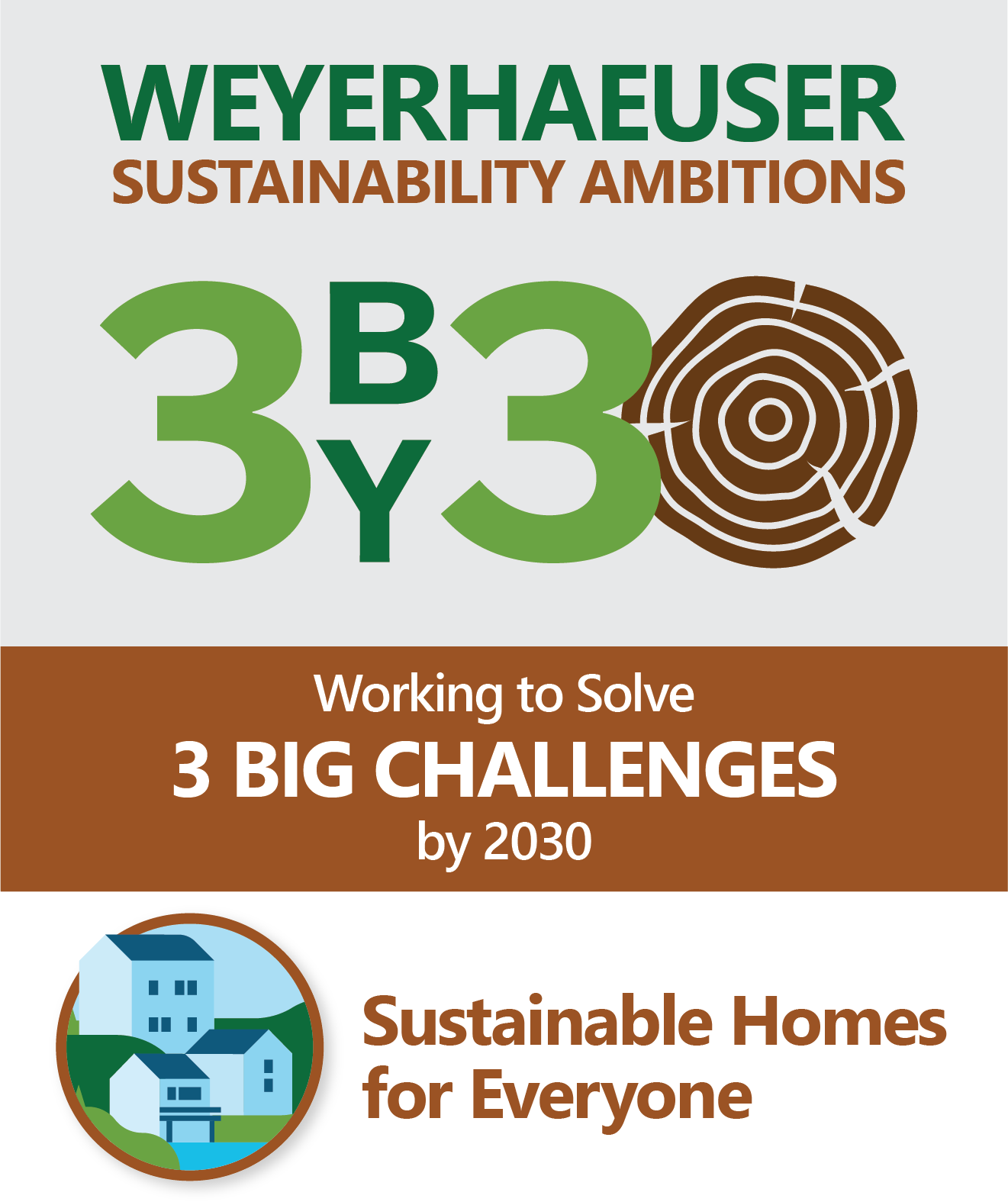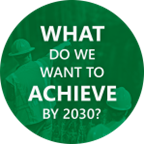 Homes
Homes
Our sustainable products help provide homes for everyone
WHAT IS THE CHALLENGE?
Few amenities are more fundamental to life and comfort than a home. For many people, home is a sacred, personal space, and it can take many forms. It can be a home in the city, suburbs or in a small town. It can be an apartment or condominium, a tiny home, a backyard dwelling, an intergenerational home or a homestead. Regardless of its form, a home is essential shelter — yet quality, affordable, sustainable housing is in short supply in communities across North America. In fact, research continues to show the housing supply deficit in the United States remains between 1.5 million to 2 million units. While construction and building materials are certainly part of the cost of building new homes, real estate costs (the land) and flexible zoning are the primary drivers of this shortage. A preference for single-family zoning diminishes affordability and access. Adding to the challenge, housing costs and rental prices are increasing, while median household income remains relatively flat.

WHAT IS OUR ROLE?
We believe that by working with partners and applying our deep industry and supply chain expertise, we can significantly increase the overall availability of quality housing — faster, more efficiently and at a scale to make a real difference for communities of all sizes across North America. We see two main areas where we can play an important role in accelerating the volume, sustainability and diversity of available housing. The first involves supporting innovation in the wood products industry to increase the prevalence of wood-based buildings through improved construction methods and updated building codes to allow wood construction in midrise buildings. The second involves supporting the development of offsite construction and non-traditional housing options, including accessory dwelling units, tiny homes and other detached structures, aimed at providing flexible, efficient alternatives and new housing solutions. Recognizing wood as the most renewable, versatile and cost-effective building material is essential for developing sustainable options that meet various income levels and geographies.
WHAT DO WE WANT TO ACHIEVE BY 2030?
By 2030, we envision a world where sustainable wood products provide abundant, diverse options that ensure everyone has access to quality, sustainably built housing. We want to help lead a paradigm shift where people have more housing options — of all shapes and sizes — anchored in natural, renewable and high-quality materials.
WHERE WE ARE FOCUSED FOR PHASE 2 (2023 – 2025)?
While there is much we can accomplish over a decade, we have structured our long-term goals into three-year phases to effectively prioritize and accelerate progress. Currently, we are two-thirds of the way through the second phase of our 3 by 30 Homes Sustainability Ambition — running from 2023 to 2025 — and are focusing on two key areas:
1. Supporting innovation and development of wood-based construction methods to replace less sustainable, nonrenewable materials
Through updated building codes, advanced techniques and material innovation, we see an opportunity to create more housing units on the same land by expanding the use of wood-based construction methods.
Actions include: policy work focused on advancing supportive legislation; sponsorship of wood-based design and innovation competitions; support and sponsorship of wood-based and mass timber education events; and more.
2. Increasing available housing options by supporting innovations to improve construction speed and efficiency, as well as high-quality alternative and diverse home-building efforts
By improving supply chain efficiency and reducing building cycle time and waste, we see opportunities to develop more housing with the same labor, time and money.
Actions include: Supporting advocacy activities focused on affordable housing with a diverse range of partners; working with the Bipartisan Policy Center’s Executive Council for Housing Affordability; supporting programs focused on developing or increasing access to high-quality alternative or diverse housing; and supporting industry events to educate designers and contractors on improving construction speed and efficiency.
PHASE 2 ACCOMPLISHMENTS
During the second phase of our 3 by 30 Sustainability Ambitions, we are intentionally making fewer, but more strategic, investments of our time and resources. While much of our work is ongoing, we have already achieved several important milestones.
- We joined the Executive Council for Housing Affordability, part of the J. Ronald Terwilliger Center for Housing Policy. By participating on the council, we are engaging stakeholders in important conversations about the role of wood products in affordable housing.
- In 2024, we partnered with Habitat for Humanity to launch the Weyerhaeuser Innovation Challenge. Participating Habitat affiliates developed and implemented ideas to use wood products to increase fair access to affordable homes, demonstrating sustainability and resilience. Winning ideas focused on workforce development, disaster resilience and construction-waste reduction, with most having the potential to be scaled across Habitat’s 1,100 affiliate locations.
- We expanded our partnerships with the University of Arkansas’ Fay Jones School of Architecture and Clemson University’s Wood Utilization + Design Institute, engaging students and academic and professional communities on both campuses about building sustainably with wood through applied research, projects and seminars. At the University of Arkansas, we supported two applied research and design projects: prototyping a 3D-printed, wood-composite house and engineering mass timber for three common housing typologies important to rural communities. At Clemson, we supported the creation of a design studio and competition to address affordable housing through sustainable design.
FOUNDATIONAL SUCCESSES FROM PHASE 1 (2020 – 2022)
In the first phase of our work, we focused on laying the foundation for meaningful progress. We learned that increasing construction efficiency and expanding options for unconventional housing are highly interconnected and adjusted our next phase of tactics accordingly. We accomplished more than 80 percent of the actions we set out to achieve; remaining actions were rolled into Phase 2 or set aside in favor of more effective tactics.
KEY ACCOMPLISHMENTS
- In 2018, the International Code Council developed code provisions for mass timber construction projects up to 18 stories; these provisions were added to the 2021 International Building Code. Part of our ongoing activity includes working to get the IBC’s codes adopted in states throughout the U.S. Our team continues to work with partners and associations at the state level to build acceptance of mass timber, position innovative wood building materials as low-carbon options and encourage states to expand mass timber promotion and construction projects.
- In 2020, we awarded a grant to the University of Arkansas’ Fay Jones School of Architecture and Design for a research project and design studio called “Wood City: Timberizing the City’s Building Blocks.” The project received a 2021 Green Good Design Award.
- Building on this success, in 2021 we funded a second design research project, “A Just Home for the Arkansas Timberlands.” Together, these projects amplified the school’s emphasis on timber and wood products, as well as affordable housing. Both projects grew into additional work with new partners interested in using mass timber for affordable housing and in rural, forest-centered communities.
- We supported mass timber and wood innovation projects conducted by Clemson University’s Wood Utilization + Design Institute.
- In 2020, we became a Founding Partner of Ivory Innovations. To support solution development for the housing affordability crisis, Ivory Innovations brings public and private organizations together to support and promote innovations in the policy, regulations, finance, construction and design. Weyerhaeuser provides financial resources for research and supports an annual award to recognize innovative solutions and initiatives that engage university students in addressing housing affordability.
- In 2021, we were the lead sponsor for Operation Tiny Home’s “Alpha” House, a prototype for a small home, built partly with our products, that was later donated to Mattersville, a community supporting veteran housing.
- Since 2021, we have sponsored the International Mass Timber Report, which informs the International Mass Timber Conference, the world’s largest gathering of mass timber experts. We participated in panels and other discussions at the conference to learn and share information.
- In 2021, we leveraged our participation in the National Association of Home Builders International Builders’ Show to highlight our sustainability ambitions and engage our supply chain and customers in a discussion of our 3 by 30 goals and the role of wood products in expanding housing options.
- In 2021, we joined the World Economic Forum’s Sustainable Mass Timber Action Committee, a group of civil society and business leaders focused on moving sustainable mass timber from a niche opportunity to a mainstream option and developing tools to expand the use of mass timber. As part of this committee, we participated in a virtual panel on the future of this green building material.
- In 2021, our government relations team worked with our business leaders to identify innovative wood building materials and mass timber building-code adoption as top priorities in our legislative action plans.
By using this website, you agree to our Privacy Policy. California residents: See our CCPA Privacy Notice for details on what personal information we collect and for what purposes.



